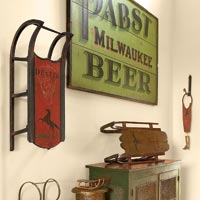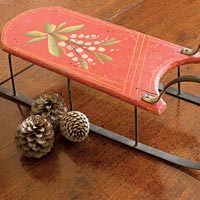 This article about sleds is from the December issue of Country Living magazine. I thought it was cute and wanted to share it with you. Especially since it is winter time and I am sure we can all remember flying down snow covered hills on sleds and sometimes the occasional trash can lid or whatever could be found that would slide on snow. :)
This article about sleds is from the December issue of Country Living magazine. I thought it was cute and wanted to share it with you. Especially since it is winter time and I am sure we can all remember flying down snow covered hills on sleds and sometimes the occasional trash can lid or whatever could be found that would slide on snow. :)Sled History
No one is quite certain where the sport has its origin. Romans supposedly used their shields as sleds in battle. Boston's Beacon Hill was a favorite launching pad in Colonial times. By the mid 19th century, amateur racing was all the rage in America, and many of the early hardwood sleds had well-known names such as Thunder, Comet and Flying Cloud. In 1861, Henry F. Morton opened one of the country's first sled factories in South Paris, Maine, where he made what came to be known, shorthand, as Paris sleds. Clippers, where the runners formed a V-shaped point, were created for boys so they could belly-flop head first down the slopes. Beauty, not speed, was de rigueur for girls. They were supposed to sit up straight on Cutters, where the runners were often curled in a bow fashion, and swan-shaped finials added a touch of elegance. Morton's wife, Lucilla, hand-painted each of these sleds with motifs of horses and dogs for lads, birds and flowers for the girls."It's the aesthetic of these finely crafted Paris sleds that drives the market today," says Leon Weiss, owner of Gemini Antiques in New York City and a collector and dealer of sleds. "The period between 1860 and 1890 is most intriguing because of the hand-painted imagery," he adds.
Trademark Looks

The Garton Toy Manufacturing Company's sleds, produced from 1879 to the 1920s with signature red decks, help support an interest in this collectible, as does the best-known name in the industry, the Flexible Flyer, the first steerable sled. In 1889, Samuel Allen of Westfield, New Jersey, patented the Flexible Flyer, whose T-shaped runners could be moved by hands or feet for turning. Their centerboards were decorated with flowers and are not as visually appealing as those of the Paris sleds. But Joan Palicia, author of Flexible Flyers and Other Great Sleds for Collectors (Schiffer Books), notes that Allen's sleds had far more significance. "To this day, it's one of the few toys that crosses gender lines and is loved by both boys and girls," she says. There's still a great interest in finding early Flexible Flyers, especially the miniature salesmen's samples, notes Leon Weiss. By 1915, however, Flexible Flyer had changed its logo to its trademark eagle, shield and ribbon and was selling at Macy's and Wanamaker's at a rate of 2,000 per day. That signaled the demise of hand-painted imagery, and for collectors it was all downhill after that.
 Miniatures
MiniaturesMiniature models of sleds, built to scale, are coveted by collectors. Measuring 16 inches in length, they were used as holiday decor and as props for dolls, and typically feature scenes of flowers with a red, green and blue backdrop. Even rarer and smaller, at nine inches long, are salesmen's samples, created by manufacturers to sell their goods.
By Steve Jermanok

2 comments:
Rue and I would go sledding all the time at the jr high near our home with our little brothers all bundled up. It was so much fun! Well, until they put me on a sled backwards and sent me down a hill and my head hit every stair on a set of bleachers that I flew under! (He will remember that!)
Ouch, Ruhiyyih! You never told me about that! Annie, I love little miniatures, and I'm going to check out your link. Have a great day.
Post a Comment